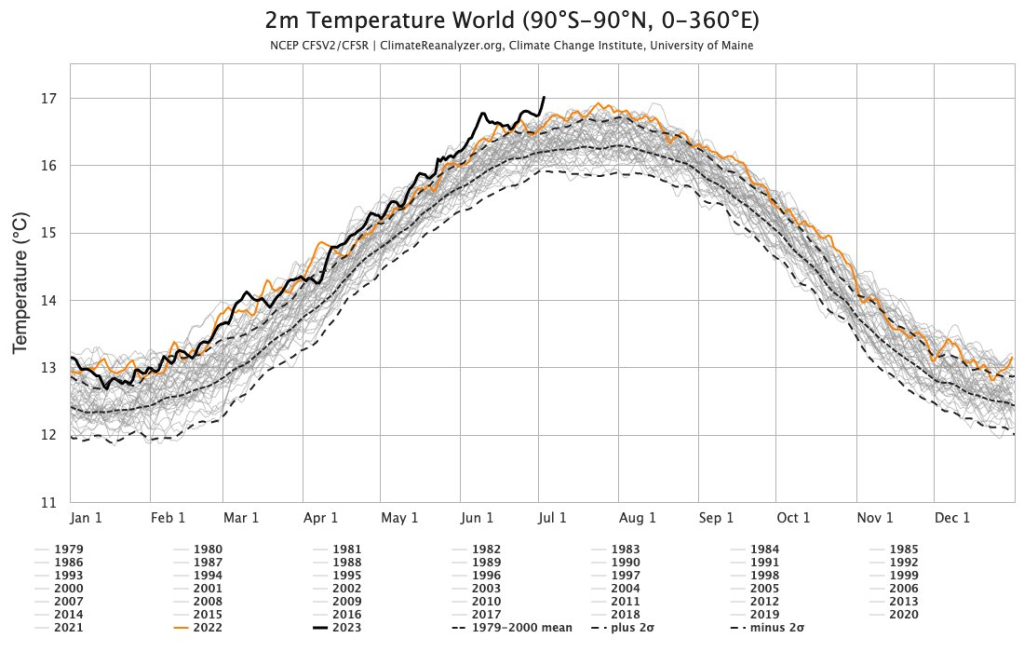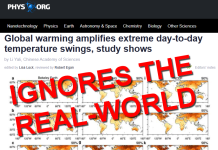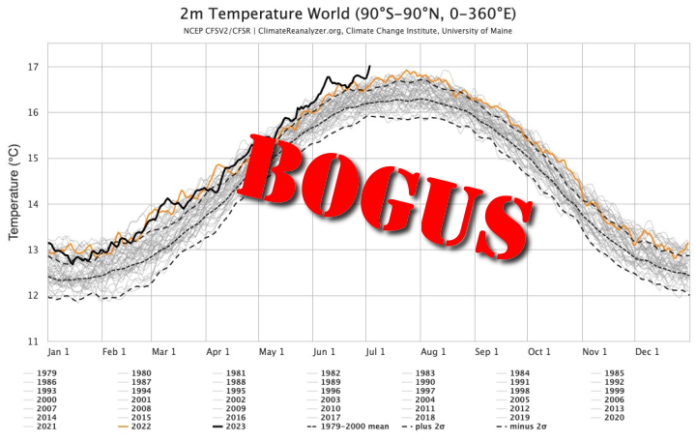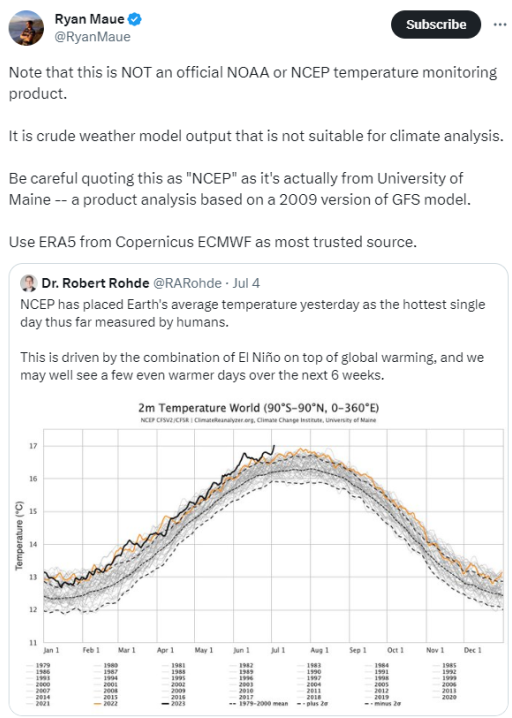On July 3rd and 4th and the following days, multiple mainstream media outlets ran stories claiming that the Earth had experienced an unprecedented hot day(s). This is false. The data they cited was not official data, but from a private website and investigation shows the claim was a gross error.
Some sample headlines from that week are:
Yahoo News: ‘Unprecedented and terrifying’: World sets all-time high temperature record 2 days in a row
Forbes: July 4 Was Earth’s Hottest Day In Over 100000 Years
UPI: Climate scientists: July 4 was hottest ever for average global temperature
CNBC: World registers hottest day since records began
In the CNBC article, reporter Sam Meredith wrote:
The planet’s average daily temperature climbed to 17.18 degrees Celsius (62.9 degrees Fahrenheit) on Tuesday, according to the University of Maine’s Climate Reanalyzer, an unofficial tool that is often used by climate scientists as a reference to the world’s condition.
“Monday, July 3rd was the hottest day ever recorded on Planet Earth. A record that lasted until … Tuesday, July 4th,” said Bill McGuire, professor emeritus of geophysical and climate hazards at University College London, via Twitter.
“Totally unprecedented and terrifying,” he added.
Apparently, all those people missed the fact that they were looking at the output of a climate model, not actually measured temperatures. Only one news outlet, The Associated Press, bothered to print a sensible caveat. In the July 5th story “Earth hit an unofficial record high temperature this week – and stayed there” reporting:
On Thursday, the National Oceanic and Atmospheric Administration distanced itself from the designation, compiled by the University of Maine’s Climate Reanalyzer, which uses satellite data and computer simulations to measure the world’s condition. That metric showed that Earth’s average temperature on Wednesday remained at an unofficial record high, 62.9 degrees Fahrenheit (17.18 degrees Celsius), set the day before.
The AP updated its story on July 7th to include this single yet very important paragraph:
NOAA, whose figures are considered the gold standard in climate data, said in a statement Thursday that it cannot validate the unofficial numbers. It noted that the reanalyzer uses model output data, which it called “not suitable” as substitutes for actual temperatures and climate records. The agency monitors global temperatures and records on a monthly and an annual basis, not daily.
So, in the space of two days, we went from temperature data that was “[t]otally unprecedented and terrifying,” to temperature data that was not suitable for purpose.
How did this happen? It was a chain of events involving “experts” on social media who first noticed this graph on climatereanalyser.org:

Note the uptick in black at the top, that’s supposedly proof of the hottest day ever in Earth’s history. Social media created a “viral” response to this, and the poorly trained yet climate narrative compliant mainstream media picked up the story and ran with it.
Some people, such as Ryan Maue, Ph.D., tried to put out the wrongheaded social media fire on Twitter. He notes that the climate model used isn’t even current, circa 2009/2011:
It seems the media, social and otherwise, saw what they expected to see and got fooled. They failed to check the source of the data before rushing to judgment.
Although, on July 8, the University of Maine’s Climate Reanalyzer website was forced to put up this notice on their global temperature page:

But even that claim is false, because in fact the NCEP CFSv2 used by Climate Reanalyzer and listed at the top of their graph, is in fact defined as a model according to its developer, NOAA:
The CFS version 2 was developed at the Environmental Modeling Center at NCEP. It is a fully coupled model representing the interaction between the Earth’s atmosphere, oceans, land, and sea ice.
So much for Climate Reanalyzer’s “not a model” claims. They simply “got caught with their pants down,” and the special notice was little more than damage control.
Even if the Climate Reanalyzer output had accurately reflected the temperature data recorded since satellites data began, there is no justification for the bizarre claims made by outlets such such as Forbes: “July 4 Was Earth’s Hottest Day In Over 100000 Years”
Note that in Figure 1, climatereanalyser.org only has data back to 1979. That makes the 100,000 year claim not just far-fetched, but impossible to verify or substantiate.
The mainstream media’s behavior in response to the claims made by Climate Reanalyzer made what should have been passed unnoticed as a bizarre outlier in climate data into headline news around the globe. This treatment was unjustifiable, a blatantly false portrayal by social media and mainstream media to push the climate crisis narrative forward. If the mainstream media had any integrity left, retractions would be published, yet there shamefully does not seem to be a single one.
























You write, “Only one news outlet, The Associated Press, bothered to print a sensible caveat.” They did not have that caveat in the original article as can be seen on the Internet Archive page: http://archive.today/VCxnQ
As you can see, the entire part about NOAA was not originally included.
Then you write they updated their story on July 7, but that update included the “sensible caveat” you claim was in the original article. It wasn’t.
And they don’t even indicate the article was revised (quite a bit)! Here’s the latest archive of the article from July 13: http://archive.today/nILWE
You can’t trust these sites to be on the level when it comes to stealth editing. There should be an addendum in the article that it was updated and what was changed.
Something is odd about ” highest temperature ” occurring near aphelion when our gray body orbital temperature is ~ 4.3c lower than at perihelion in January .
It shows a strong bias towards measuring Northern Hemisphere continental temperature .
Waiting for retractions…. crickets